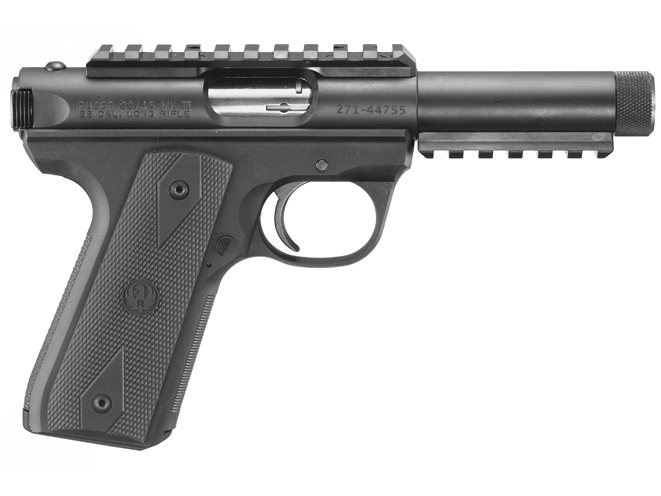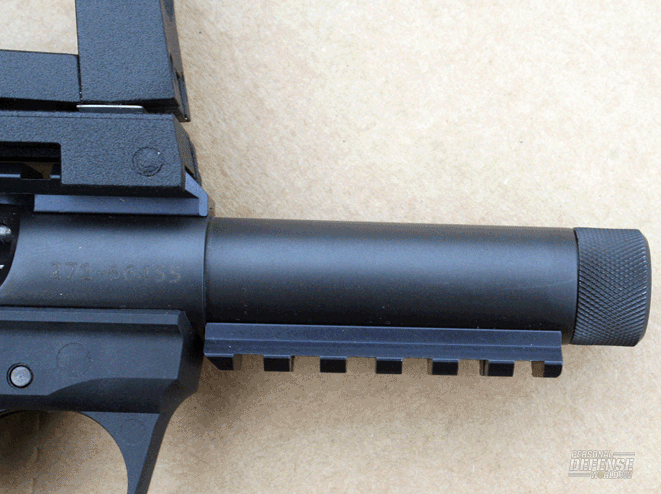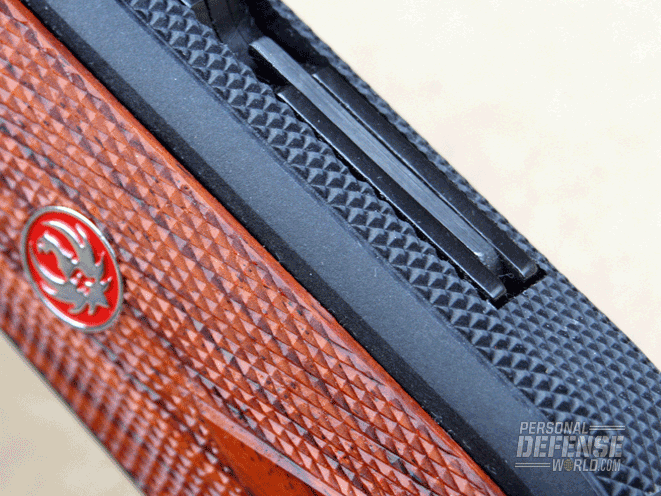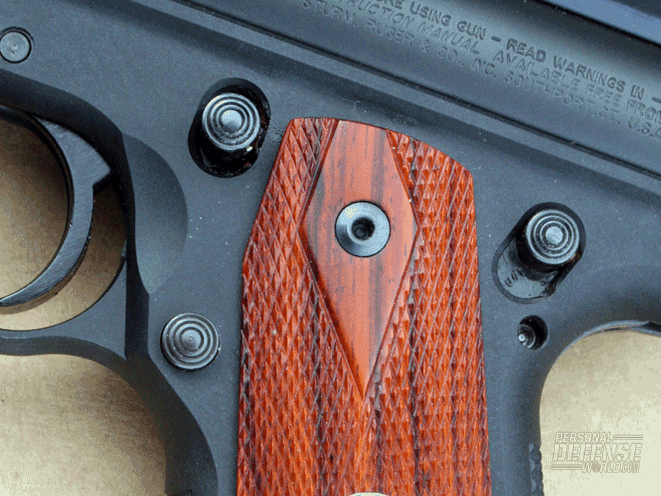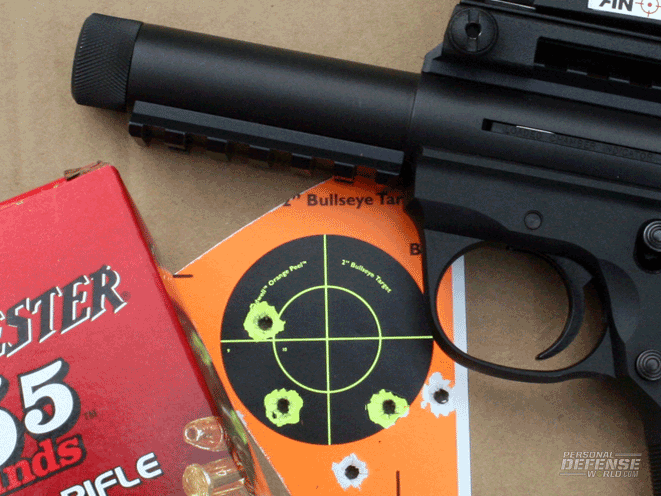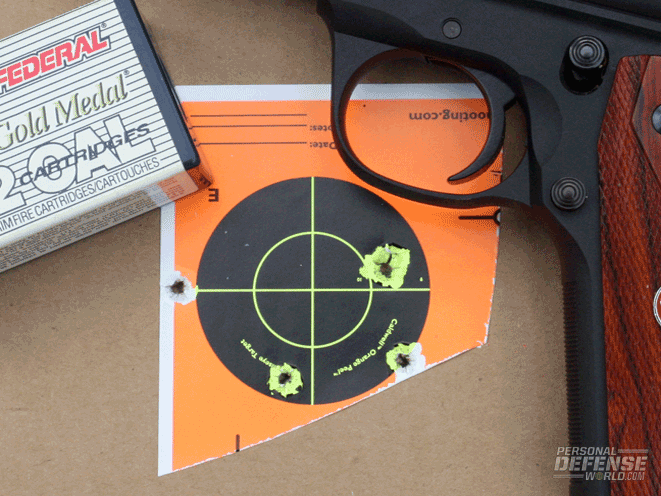When Ruger brought out the Lite and Threaded Barrel versions of its 22/45 pistol, my significant other was intrigued. She had chosen a 22/45 for her first gun in the late 1990s and bonded with it. It led her into regular shooting, followed by a Glock 19 and a passel of others. Competition shooting came next. She was soon winning pistol titles. That little Ruger .22 has held a special place in her heart and her gun safe ever since.
Now came the new Lite version. “It’s so light!” she exclaimed. “This would be great for when I take the grand-kids shooting.” She was particularly taken with the anodized “faded gold” color of the original 22/45, which made me want to retch just a little. Mars and Venus, I suppose.
RELATED: Ruger Adds Left-Handed, Ranch Models to Ruger American Rifle Bolt-Action Line
Advertisement — Continue Reading Below
We dragged our feet and didn’t buy one, and soon Ruger phased out the gold color and went to a more conventional blue/black finish. “Darn,” she said aloud when she learned that the gold-finish ship had sailed. “Thank God,” I muttered quietly.
Anyway, in September of 2013, she and I had a free day while we were in Salt Lake City teaching a class, and our friend Tommy Nelson took us to a cool gun shop there, Gallenson’s. A Ruger 22/45 Threaded Barrel caught her eye, and she asked to look at it. She said wistfully, “I’ve wanted one of these since they came out. Even though they don’t make the gold ones anymore, it’s such a nice gun.”
I could take a hint. She had a birthday coming up. I reached for my credit card and FFL, and when we got home from the trip, the pistol was waiting for us at our local gun shop.
Advertisement — Continue Reading Below
Gun Details
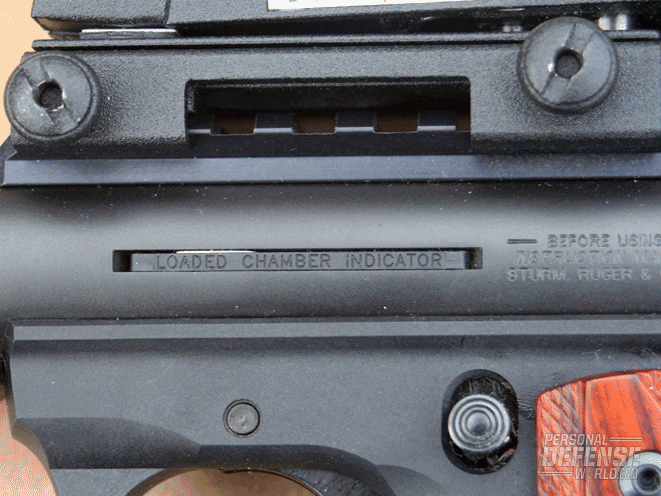
While the 22/45 Lite’s “upper” is made of aluminum instead of traditional ordnance steel, the Threaded Barrel version of the 22/45 is all steel above its polymer frame.
The 5-inch-bull-barrel version of Ruger target pistols goes back half a century or so. Its rigidity made it very accurate, and its weight gave it a muzzle-heavy steadiness when held at the end of a seasoned handgunner’s extended arm. That effect helped such shooters win matches, but it also made the gun untenably heavy for new shooters whose arm muscles weren’t acclimated to holding that much weight steady. It was likewise “just too heavy” for a lot of junior shooters, older shooters with deteriorating strength and many female shooters.
Advertisement — Continue Reading Below
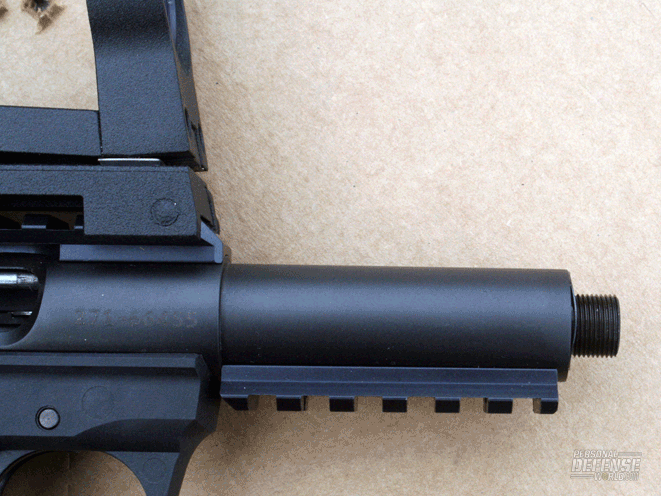
The 22/45 Threaded Barrel is not so muzzle heavy as its predecessors. At 32 ounces, it’s lighter than the old dedicated target pistols of which Ruger produced so many, though not as feathery as the 23-ounce Lite variation. The Zytel polymer frame helps with that. A tension nut at the muzzle holds the barrel sleeve in place. Remove the nut, and you find that the muzzle is threaded for a suppressor.
A little more than 20 years ago, the 22/45 was expressly designed to more or less duplicate the grip angle and “feel” of the 1911 pistol. No variation has done so more successfully than the 22/45 Threaded Barrel, with its very 1911-like grip panels. While the thumb safety lever and the slide stop lever are rounded and look more like buttons, they duplicate the function if not the look of those parts on a 1911, being in more or less the same locations and operating in the same directions.
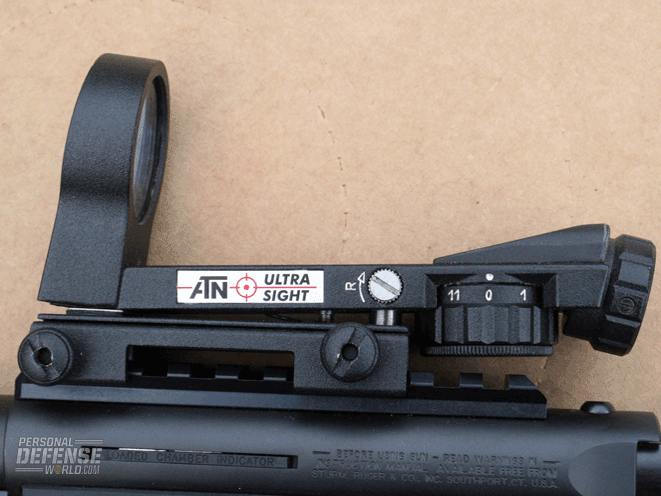
To us old folks who remember and own Ruger .22s from the early days, the slide stop is a definite improvement over the original’s. With the very old Standard Model and Mark I target version, to lock the slide open you had to hold the bolt back manually and thumb the manual safety upward at the same time. It was awkward for right-handed shooters and darn near impossible for lefties. The current arrangement, as found on the 22/45 Threaded Barrel, is vastly better.
Advertisement — Continue Reading Below
This Threaded Barrel came without iron sights (it is also available with iron sights). Instead, a rail is integral with the top of the receiver, and Ruger provides scope rings. The first thing we needed was something to aim with. My significant other had been very happy with an ATN Ultra-Sight red-dot optic we had picked up at a gun show in Illinois a few years before, and which had lived since on her tricked-out Ruger 10/22 rifle. A few Appleseed rifle-shooting events had convinced her that it was time to try a conventional telescopic sight on her 10/22 anyway, so she promptly grafted the ATN sight “Ruger to Ruger,” from 10/22 rifle to 22/45 pistol. And we were off to the range.
Range Time
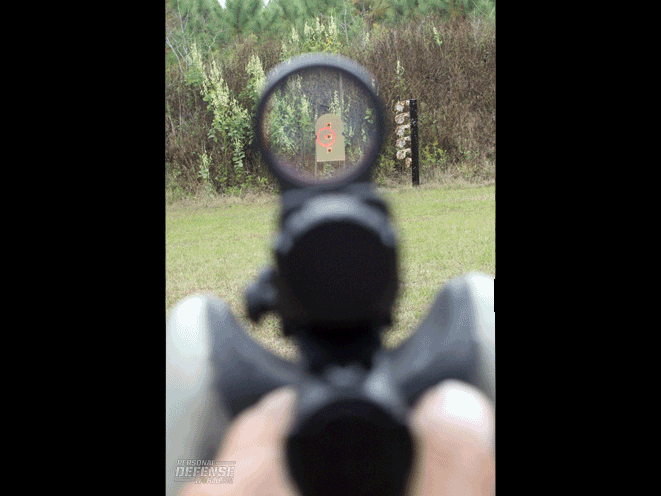
Advertisement — Continue Reading Below
Once she had dialed in her new Ruger and red-dot sight, it was time to take it to the Matrix rest on the concrete bench at the 25-yard bay of our range. Our choice of ammo was sort of like the Sears, Roebuck catalogs of our youth: “Good, Better, Best”-grade stuff. We started with generic .22 fodder, went to slightly more expensive ammunition that actually said “match” in its advertising and then progressed to elite, truly match-grade .22 LR ammunition.
RELATED: Ruger Introduces New LCR in 9mm
“Good” was Winchester’s “bulk pack” 36-grain, plated-hollow-point ammunition, designed for hunters and plinkers and the rest of us hoi polloi. It turned out that “good” was very good indeed, giving us the best five-shot group of the test, at 1.75 inches. The best three of those shots, which tell us what the whole group might have looked like had we been without human error, was a respectable 1.1 inches.
Advertisement — Continue Reading Below
“Better” was Federal Auto Match, which oddly enough has found its way into the biggest of the Big Box stores in the past few years. It’s a lead, 40-grain solid whose packaging promises a velocity of 1,200 fps. Five shots clustered into 2.5 inches, and the best three shots grouped into 1.5 inches.
“Best” was another Federal load, the Gold Medal Ultra Match. Its 40-grain lead bullet leaves the barrel at a staid “stand-ard velocity.” Mine was private stock from production lot 425, and it delivered its quintet of bullets into 1.95 inches. However, its tightest three-shot cluster was the best of the test, a mere 0.8 inches. Federal does not use such terms as “Gold Medal” or “Ultra Match” lightly.
There is a long, almost effortless take-up on the 22/45 Threaded Barrel before the finger feels seriously palpable resistance from the trigger. Then there’s a very short and slight roll to the rear until the sear releases and the shot is fired.
Advertisement — Continue Reading Below
My Lyman digital trigger pull gauge showed very consistent trigger resistance from first shot to last. The pull weight averaged 3.89 pounds.
Looking at this pistol as a starter or training gun, what was more important to me is that the Threaded Barrel has a fairly short trigger reach. This means small hands and short fingers can reach the trigger easily, aiding in good trigger control.
Par Excellence
Advertisement — Continue Reading Below
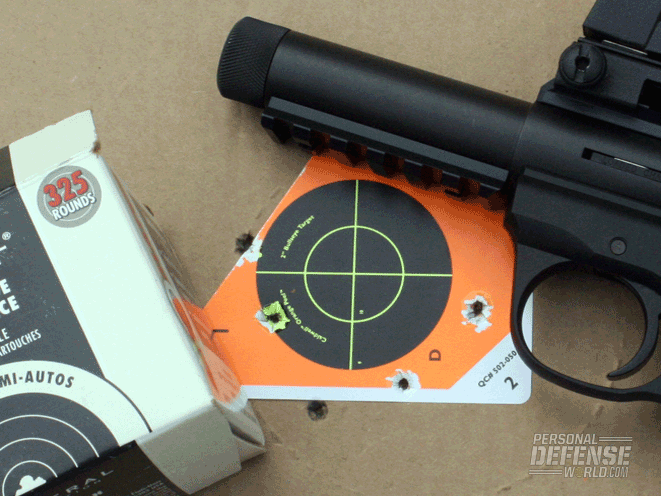
Reliability is the hallmark of Ruger .22s. My significant other and I have put a bunch of bullets through this one, and it has yet to malfunction. That high order of reliability was no surprise. When I was a teenager and started shooting in NRA pistol matches, I spent a lot of time working the line at club matches. The three most common .22 target pistols of the time were the High Standard Supermatic, the Smith & Wesson Model 41 and the Ruger Mark I. I couldn’t help but notice that the tightly fitted S&Ws jammed more often than the High Standards, and they both jammed more often than the humble Ruger. It was club policy that misfired rounds be set aside for subsequent disposal. Some of us would take those misfired rounds and try to shoot them later. In a Ruger, they would light off every time, unless the cartridge was a true dud. That told me something.
RELATED: Gun Review – Ruger’s Bug-Out 22/45
This pistol is a plinker par excellence. It will not give the superb accuracy of a heavy steel Ruger target barrel on that rigid tube in which the bolt rides, the accuracy that allowed the late, great Jim Clark Sr. to become the first private citizen to capture the U.S. National Championship in bullseye shooting some 60 years ago. Jim’s feat “made” the Ruger a competition target pistol, and it has been widely seen on the ranges at Camp Perry ever since. Just as an aside, the Ruger and Clark names have also been intertwined ever since. Now run by the next generation, the Clark gunsmithing bus-iness in Shreveport, Louisiana, is still the recognized leader in customized and accurized Ruger rifles and pistols. Jim Clark, Jr. is the only 3-Gun shooter to my knowledge to win championships with a Ruger Mini-14 rifle shooting against masters with AR-15s. Kay Clark-Miculek, a champion shooter in her own right, makes the best 10/22 match rifles I’ve ever seen. I cherish mine. Generations of shooters have improved their Ruger .22s simply by installing Clark triggers.
I say all this simply for perspective. Ruger’s Mark III dedicated target pistols are built to group all shots in an inch at 25 yards. While the 22/45 Threaded Barrel shows potential to make this cut, when you look at the “best three” clusters with the best ammo, they aren’t as tight as I’d expect from a Ruger target model. Simply put, this little gun is built for fun.
And it delivers. We found ourselves making ammo runs back to the house for more of those carefully stockpiled little cartridges. Good .22s are addictive. In a good way.
This pistol also has a light rail molded into the barrel shroud. I can definitely see this for pest control at night on the farm, or places where night hunting for rac-coons is legal. When time permits, there’s going to be some after-dark plinking with this 22/45 and a white light, or maybe a light and laser sight, attached.
Final Notes
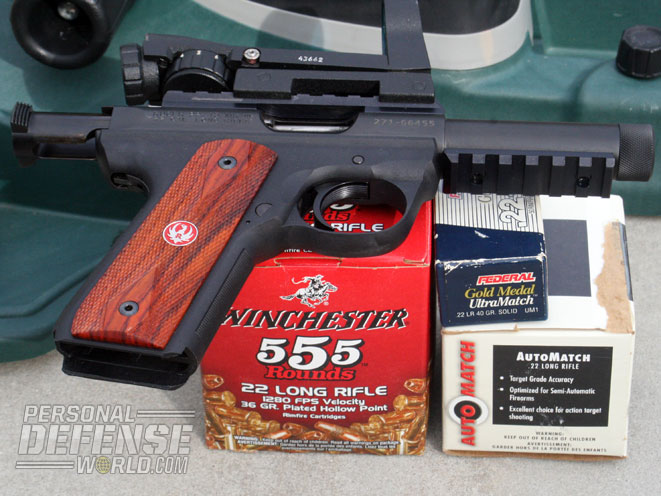
The first Ruger firearm was the fore-bear of this test gun, the original Ruger Standard Model. When it came out in 1949, its price was $37.50, and the company held the MSRP there for an amazingly long time. Industry insiders believe that this was the gun that killed off the fine old Colt Woodsman because it gave the same superb reliability, outstanding accuracy and excellent “feel” of the Woodsman at a much lower retail price. Ever since, when a gun magazine or outdoor pub-lication did a compilation of “best buy” firearms, the Ruger .22 LR always seemed to make the list.
RELATED: Crimson Trace Unveils New Lasergrips for Ruger LCR & LCRx
My very first handgun of my own was a Standard Model, which I got when I was 11 years old. My dad bought it used in excellent condition for $20 in the late 1950s. This specimen was so old it still had the red Ruger symbol on it, before Alexander Sturm died and Bill Ruger changed it to black in mourning. It was accurate and I don’t remember it ever jamming. It was a relatively heavy, all-steel pistol, though, and at least in my family back then, we shot handguns with only one hand. It was just too heavy for my 11-year-old arm to hold with sufficient steadiness. We traded it in for a much lighter High Standard Sentinel .22 revolver, which worked better for me at the time.
After 65 years of Ruger .22 pistols, we have the Standard Model’s distant de-scendant, the 22/45 Threaded Barrel. Tradition and fond memory aside, I have to say this newest iteration is a better gun. And it has a price of $449.
When you factor in inflation since 1949, that’s still a bargain for the quality and reliability the Ruger 22/45 Threaded Barrel brings to the shooting bench. For more information, visit ruger.com
Specifications: Ruger 22/45 Threaded Barrel
* Caliber: .22 LR
* Barrel: 4.5 inches
* OA Length: 8.5 inches
* Weight: 32 ounces (empty)
* Grips: Black laminate
* Sights: None
* Action: SA
* Finish: Black anodized
* Capacity: 10+1
* MSRP: $449
Performance: Ruger 22/45 Threaded Barrel
* Federal 40 Auto Match – 2.50
* Federal 40 Gold Medal Ultra Match – 1.95
* Winchester 36 HP – 1.75
* Bullet weight measured in grains, and accuracy in inches for best five-shot groups at 25 yards.
This article was originally published in COMPLETE BOOK OF HANDGUNS 2014. Subscription is available in print and digital editions below.
